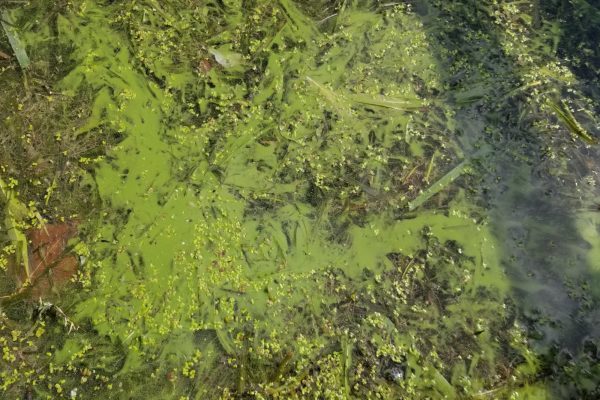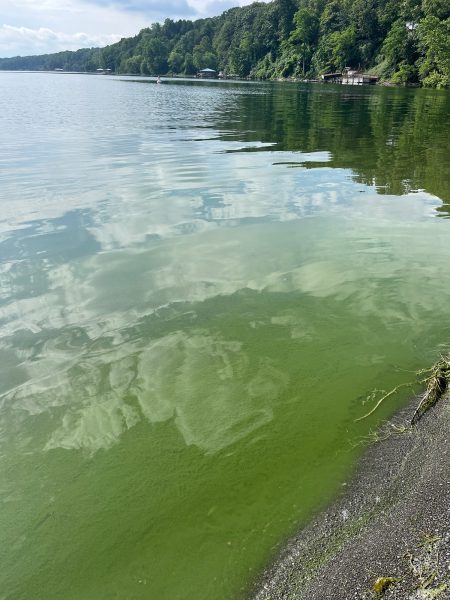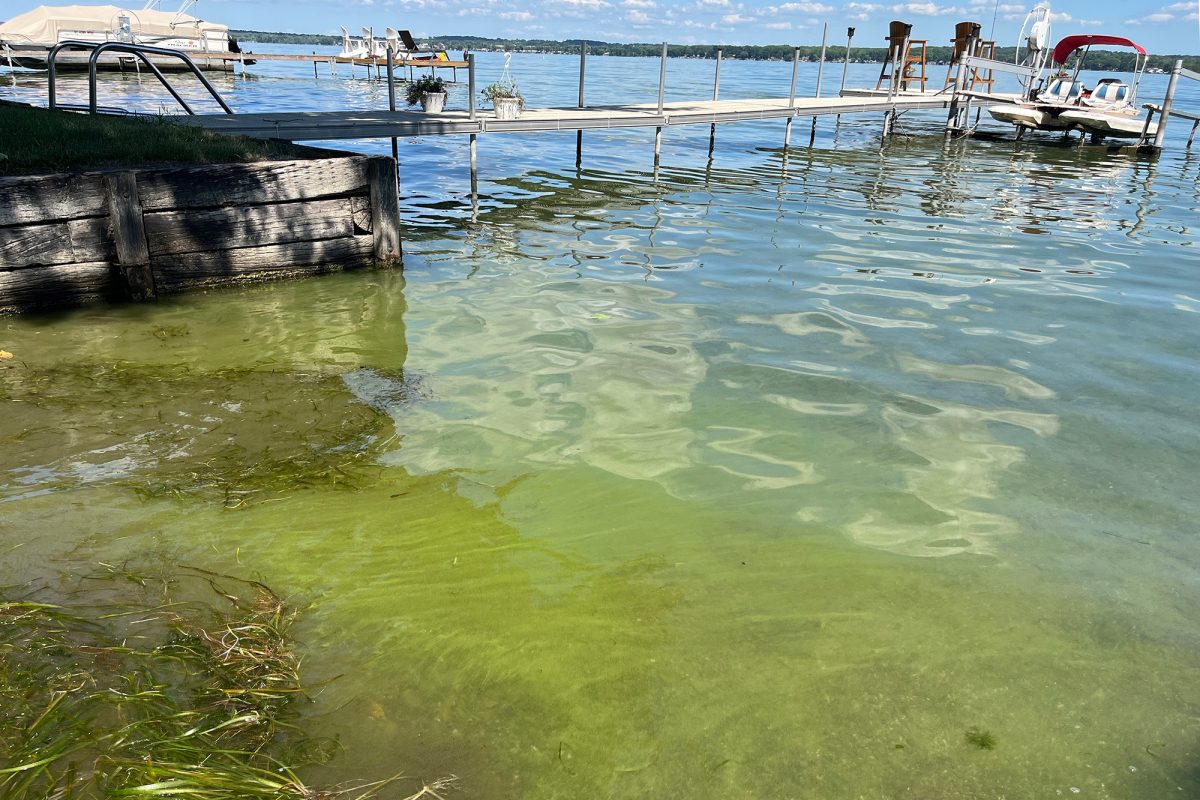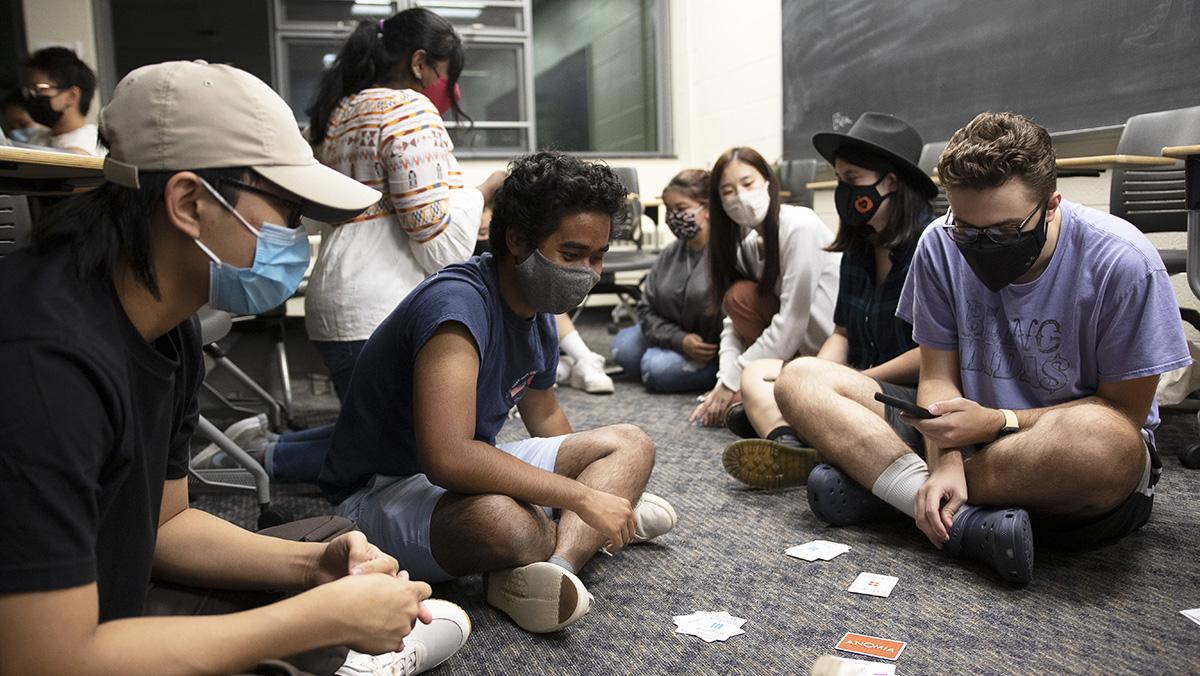In the summer months around Cayuga Lake, familiar green clumps can be spotted on the water. These are harmful algal blooms (HABs), potentially toxic growths of bacteria that can harm people and animals. As Earth’s temperature continues to rise, HABs reports have drastically increased over the last four decades, making them a more difficult issue to contain. However, the Ithaca community has many ways of managing them.
Not all algae and algal blooms are harmful. Algae are an important part of lake ecosystems, providing food and cover for smaller fish. However, when conditions are right, a type of photosynthesizing bacteria called cyanobacteria can rapidly grow and “bloom,” potentially harming the environment, animals and humans. HABs first appeared in Cayuga Lake in 2014, growing more frequent through the latter half of the 2010s.
Exposure to cyanobacteria can cause an array of health issues. Exposure to cyanobacteria toxins can result in loss of appetite and energy, vomiting, respiratory issues, rashes and possibly death. Signs along the lake warn visitors when the blooms are present, which can last through October.
Cyanobacteria thrive in periods of extended sunlight and their growth is accelerated by rainwater runoff and increases in nutrients. Nutrients like phosphorus and nitrogen are abundant in agricultural fertilizers which are washed from surrounding areas into the lake during rainstorms.
Blooms look like blue-green clumps or paint-streaks on the surface of the water, almost like pea soup. Just from appearance, it is impossible to determine whether the blooms are toxic or not. HABs often appear at the lake shore and in warm, shallow waters. Blooms can be in specific areas or lake-wide.

Since cyanobacteria grow in the sun and storms, climate change will increase the frequency and severity of HABs. Susan Allen, professor and chair of the Department of the Environment at Ithaca College, said that while the Town of Ithaca is relatively climate resilient, HABs will increase in frequency and severity as the climate changes.
The U.S. Climate Vulnerability Index has Tompkins County in the 16th percentile for severity, listing it as low vulnerability. Allen said this is due to the area not being in any major hurricane paths, being above sea level and having many months of cold weather. Additionally, rich freshwater resources reduce vulnerability.
“We’re fairly well protected,” Allen said. “But I don’t think we are necessarily climate stable, it’s not like we’re not going to get any warmer.”
Alyssa Johnson, outreach and program manager at the Community Science Institute, said there is no way to disperse HABs once they appear, and the best course of action is to simply avoid them. Johnson works with the Cayuga Lake HABs Monitoring Program, a program at the CSI made up of around 100 volunteers who work to document and test HABs across Cayuga Lake. This program has been active since 2018 and the volunteer members are known as HABs Harriers.
“I let them all know where and when a bloom has been seen or reported,” Johnson said. “Those volunteers … are asked to collect a sample. It’s administrative, letting certain people know, putting it in the database and reporting it to the state.”
Junior Sasha Bath stayed in Ithaca over the summer, working at Taughannock Falls State Park. He said the designated swimming areas were often closed due to HABs.
“People were definitely a little disappointed; they’d come to us asking what the details were,” Bath said. “We would tell them they could kayak and we would strongly recommend against going in the water.”
Cyanobacteria produce toxins called cyanotoxins that have the potential to make people and animals sick. Johnson said there has never been a recorded human death from cyanotoxin, however pets and livestock are much more at risk.
“[Dogs] will go in the water, drink the water [and] they’ll groom their fur,” Johnson said. “I tell people if you think your dog has symptoms, they often start looking and acting like they’re drunk. It affects them neurologically.”
Johnson said doctors and veterinarians do not yet have specific protocols and procedures for recognizing and treating cyanotoxin poisoning. She said she has spoken to people living by the shore of Cayuga Lake who have lost their dogs to cyanotoxin poisoning and that getting the animals emergency veterinary care in time is key to their survival.
“One of our volunteers [at CSI] is a retired doctor, and I asked him last week, if I came to you with this set of symptoms and I said, ‘I think it was a HABs bloom,’ what would you do? And he’s like, ‘honestly, I’m not sure,’’’ Johnson said. “It’s very complicated and it’s not black and white which makes it very hard for many people to grasp and understand. They just want an answer like, ‘Can I swim or not?’’’
HABs in the lake pose potential safety risks for Tompkins County residents. The towns of Ithaca, Dryden and Lansing all draw water from Cayuga Lake using the Bolton Point water system.
Glenn Ratajczak, production manager at Bolton Point, said there have not been any HABs at the intake site for Bolton Point, however it would change the treatment process if it happened. The intake site for Bolton Point is 400 feet from shore and 65 feet deep, where HABs are not present. Johnson said the drinking water risk is faced mostly by residents living alongside the lake who may draw water from shoreline wells near their homes.
“They could be unknowingly consuming [cyanobacteria],” Johnson said. “A toxin we see is a hepatotoxin, it could cause liver failure [or] different issues with your liver.”
When HABs are present, they can create economic challenges around the lake. Stanley Pierce, captain of Redbeards Finger Lakes Charters, said HABs can cause challenges for fishing tours because fish avoid affected areas and will not see the lures when they are in the water.

“[We get] a lot of tourists that are up vacationing,” Pierce said. “If it’s bad at one side, we go to the other side. If it’s bad all over, we just go to a different lake.”
Ratajczak said he worries about the impact of HABs on tourists and the non-local perception of Cayuga Lake.
“It taints how tourists think of the lake,” Ratajczak said. “When they’re here and the beaches are closed and they can’t swim, they assume right away that it’s polluted.” HABs season typically runs from June to October each year. While the problem is complex, it is closely monitored and not unique to Cayuga Lake. They are present in warm, calm waters across the world.















